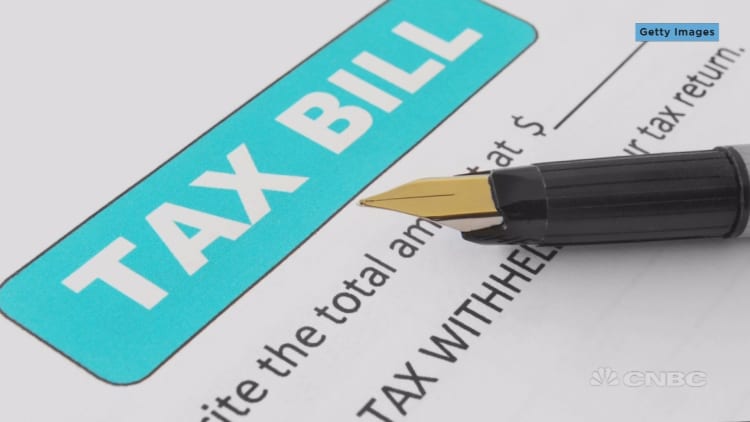For many people, the days leading up to New Year's Eve are filled with holiday shopping returns, ugly sweaters and eggnog. It's also the time to make some final moves to lower your 2016 tax bill.
From making a last-minute charitable donation to an early college tuition payment, now is the last chance to reduce what you'll owe Uncle Sam.
So before the ball drops in Times Square, cross these tax moves off your list.
Donate

The holidays go hand in hand with charitable donations. Contributions are tax deductible up to 50 percent of your income and will count for 2016 as long as payments are mailed by the last day of the year, according to the IRS.
There are also options beyond writing a check. For example, if you are stocking up at the supermarket for a food-collection truck or purchasing winter coats for a coat drive, that's all deductible as well.
Other noncash donations work, too: Cleaning out your closets and donating old clothing, books, toys, furniture and kitchen goods can count toward your charitable contribution (in that case, you can only deduct the thrift shop or fair market value, which is less than retail).
In order to get the deduction, keep a receipt, a note of the organization's name, the date and fair market value of all noncash goods, said Kathy Pickering, executive director of H&R Block's Tax Institute.
Educate
Families saving for college should consider contributing to a 529 college savings account before the end of the year. While contributions to 529 plans are not deductible for federal taxes, over 30 states and the District of Columbia may offer a full or partial deduction or credit for those contributions, according to Robert Steen, director of complex financial planning for USAA. The deduction or credit can vary, depending on the state plan.
More good news: Those with children starting college, graduate school or even taking a single class can prepay their tuition before Jan. 1 to get the tax benefit in 2016, according to Lisa Greene-Lewis, CPA and tax expert at TurboTax.
Spend
Check what's left in your flexible spending account or health savings account so you can spend that money before the year ends. Those are tax-free dollars that you can put toward new glasses, filling prescriptions or dental care that isn't covered by insurance, like a replacing a filling, said H&R Block's Pickering.
And while you are looking at your medical expenses, add them up, Pickering said. You may have incurred enough to hit the medical expense threshold (which is 10 percent of your adjusted gross income if you are under age 65), and in that case, you can deduct everything you've spent over that figure — but you can't double dip. In other words, you cannot claim a tax deduction for medical and dental expenses you paid with funds from your flex spending or health savings accounts.
Save
Many people also make extra retirement contributions around now, and much of what you put toward your nest egg is a tax savings, too. "If you contribute to your 401(k), you lower your taxable income," said Greene-Lewis.
If you are 18 or older, you can max out your contributions up to $18,000, and if you are over 50 you can put in an additional $6,000 for a total of $24,000. Those contributions must be made by Dec. 31.
With IRAs you have until April 2017 to contribute up to $5,500, and if you are over 50 there's an additional $1,000. Those who are self-employed can make additional tax-deductible contributions to a Simplified Employee Pension account, or SEP IRA. (Those savers can contribute up to 25 percent of their net earnings for a maximum contribution of $53,000 this year and they also have until the tax due date to do it.)
Then you can also profit from the Saver's Credit come Tax Day, which can be taken for contributions to a 401(k), traditional or Roth IRA or SEP, of up to $2,000 (or $4,000 if married and filing jointly), depending on your income. In this case, you can double dip, according to Greene-Lewis. That's what's called a "double benefit."
Distribute
Taxpayers who are over age 70½ are generally required to take a required minimum distribution, or RMD, from their individual retirement accounts and workplace retirement plans by the end of the year (with the exception of those who reached 70½ in 2016 who can wait until April thanks to a special rule). "Or else you could be hit with a 50 percent penalty, which is an astounding number," said Josh Jalinski, president of financial planning firm Jalinski Advisory Group in Toms River, New Jersey.
Despite that steep penalty, retirees tend to procrastinate. As of Dec. 2, about 41 percent of Fidelity customers required to take an RMD hadn't yet withdrawn the full amount they need to. Aim to line up your distribution ASAP, if you haven't already.
But if you don't need the income, one option is to donate all or part of your withdrawal to a charity — simultaneously meeting your RMD obligation without paying taxes on the money and making your annual charitable contribution.
That's killing two birds with one stone.


